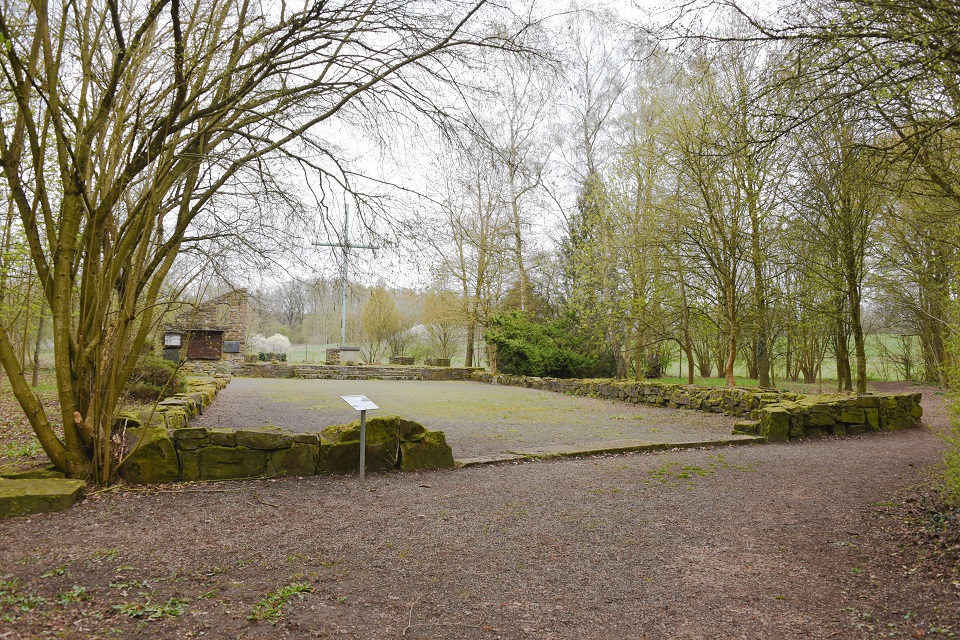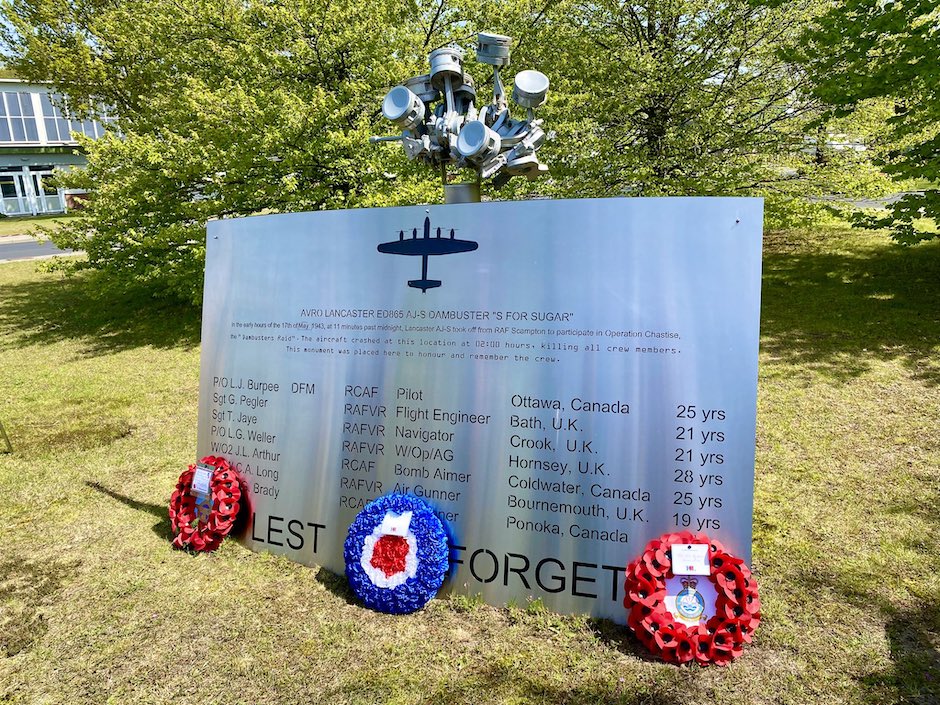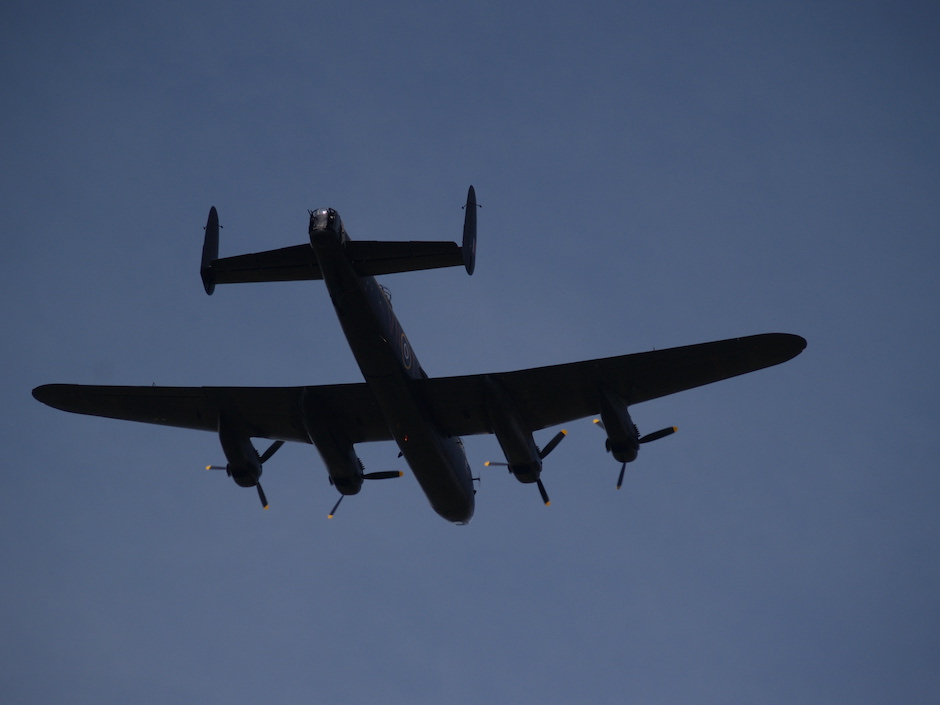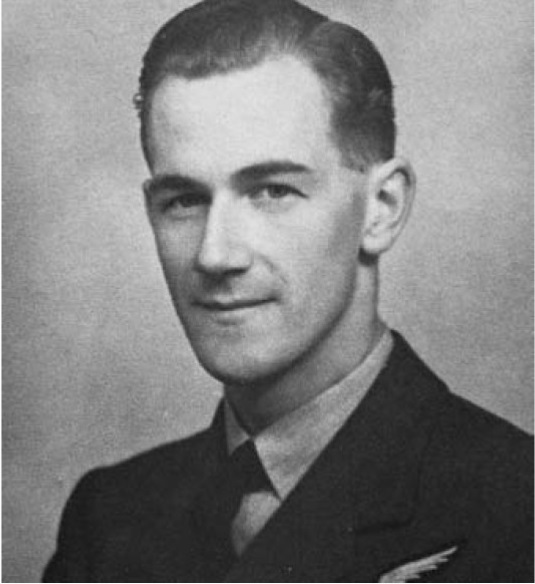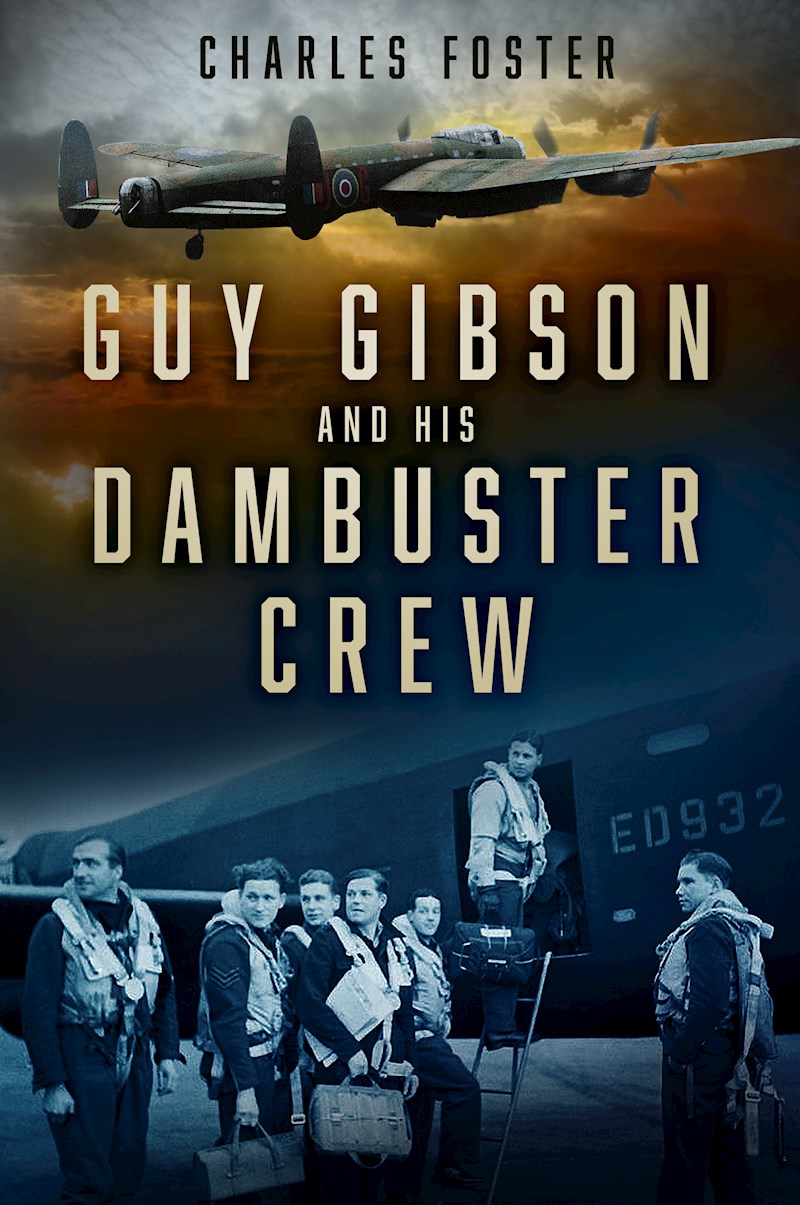
This year marks the first anniversary of the Dams Raid to take place after the death on 7 December 2022 of Sqn Ldr George ‘Johnny’ Johnson, aged 101, the last survivor of the 133 men from the Allied forces who took part in it.
A complete list of these men from British, Canadian, Australian, New Zealand and American air crew is shown below. The raid was undertaken by 617 Squadron of the RAF, specially formed for the operation and took place on 16 and 17 May 1943, eighty years ago this week. Eight of the nineteen Lancaster aircraft which carried out the raid, taking off from RAF Scampton in Lincolnshire, were destroyed, resulting in the loss of 53 crew men. Three more men were captured and remained prisoners of war until 1945.
The Dams Raid caused the collapse of two significant dams in the Möhne and Eder valleys, resulting in a large loss of life. These should not be ignored on this anniversary. The official records show that 1,294 people died as the result of the breach of the Möhne Dam, with 794 listed as ‘foreigners’ of whom 493 were Ukranian women labourers, ordered back to their camp for safety when the air raid warnings were sounded. A further 47 lives were lost in the Eder valley.
The names of the aircrew appear below in the order of the three designated ‘waves’: the first tasked to attack the Möhne and Eder dams, the second to attack the Sorpe, and the third flying as a mobile reserve. Each aircraft is listed in the order in which they took off.
Each man has an individual entry on this blog, and the link to his page appears under his name here.
AJ-G
Wg Cdr G P Gibson DSO & Bar DFC & Bar
Pilot AJ-G
Survived Dams Raid
Awarded VC
Born Simla, India, 12 August 1918
KIA 20 September 1944 [Read more]
Sgt J Pulford
Flight engineer AJ-G
Survived Dams Raid
Awarded DFM
Born Hull, 24 December 1919
KIA 13 February 1944 [Read more]
Plt Off H T Taerum
Navigator AJ-G
Survived Dams Raid
Awarded DFC
Born Milo, Alberta, Canada, 22 May 1920
KIA 16 September 1943 [Read more]
Flt Lt R E G Hutchison DFC
Wireless operator AJ-G
Survived Dams Raid
Awarded Bar to DFC
Born Liverpool, 26 April 1918
KIA 16 September 1943 [Read more]
Plt Off F M Spafford DFM
Bomb aimer AJ-G
Survived Dams Raid
Awarded DFC
Born Adelaide, South Australia, 16 June 1918
KIA 16 September 1943 [Read more]
Flt Sgt G A Deering
Front gunner AJ-G
Survived Dams Raid
Awarded DFC
Born Kirkintilloch, Scotland, 23 July 1919
KIA 16 September 1943 [Read more]
Flt Lt R D Trevor-Roper DFM
Rear gunner AJ-G
Survived Dams Raid
Awarded DFC
Born, Shanklin, Isle of Wight, 19 May 1915
KIA 31 March 1944 [Read more]
AJ-M
Flt Lt J V Hopgood DFC & Bar
Pilot
Killed on Dams Raid
Born Hurst, Berkshire, 29 August 1921 [Read more]
Sgt C C Brennan
Flight engineer
Killed on Dams Raid
Born 22 February 1916, Calgary, Alberta, Canada [Read more]
Flg Off K Earnshaw
Navigator
Killed on Dams Raid
Born Bridlington, Yorkshire, 23 June 1918 [Read more]
Sgt J W Minchin
Wireless operator
Killed on Dams Raid
Born 29 November 1915, Bourton on the Water, Gloucestershire [Read more]
Flt Sgt J W Fraser
Bomb aimer
Survived Dams Raid. PoW.
Born 22 September 1922, Nanaimo, British Columbia, Canada
Died Saltery Bay, British Columbia, Canada, 2 June 1962 [Read more]
Plt Off G H F G Gregory DFM
Front gunner
Killed on Dams Raid
Born Govan, Glasgow, 24 June 1917 [Read more]
Plt Off A F Burcher DFM
Rear gunner
Survived Dams Raid. PoW.
Born Vaucluse, Sydney, Australia, 15 March 1922
Died Hobart, Tasmania, Australia, 9 August 1995 [Read more]
AJ-P
Flt Lt H B Martin DFC
Pilot
Survived Dams Raid
Awarded DSO
Born Edgecliffe, Sydney, Australia, 27 February 1918
Died London, 3 November 1988 [Read more]
Plt Off I Whittaker
Flight engineer
Survived Dams Raid
Born Newcastle on Tyne, 9 September 1921
Died Wendover, Buckinghamshire, 22 August 1979 [Read more]
Flt Lt J F Leggo DFC
Navigator
Survived Dams Raid
Awarded Bar to DFC
Born Sydney, Australia, 21 April 1916
Died Brisbane, Australia, 11 November 1983 [Read more]
Flg Off L Chambers
Wireless operator
Survived Dams Raid
Awarded DFC
Born Karamea, New Zealand, 18 February 1919
Died Karamea, New Zealand, 1 March 1985 [Read more]
Flt Lt R C Hay DFC
Bomb aimer
Survived Dams Raid
Awarded Bar to DFC
Born Renmark, South Australia, 4 November 1913
KIA 13 February 1944 [Read more]
Plt Off B T Foxlee DFM
Front gunner
Survived Dams Raid
Born Queensland, Australia, 7 March 1920
Died Nottingham, 6 March 1985 [Read more]
Flt Sgt T D Simpson
Rear gunner
Survived Dams Raid
Awarded DFM
Born Hobart, Tasmania, Australia, 23 November 1917
Died Hobart, Tasmania, Australia, 2 April 1998 [Read more]
AJ-A
Sqn Ldr H M Young DFC & Bar
Pilot
Killed on Dams Raid
Born London, 20 May 1915 [Read more]
Sgt D T Horsfall
Flight engineer
Killed on Dams Raid
Born Bramley, Yorkshire, 16 April 1920 [Read more]
Flt Sgt C W Roberts
Navigator
Killed on Dams Raid
Born 19 January 1921, Cromer, Norfolk [Read more]
Sgt L W Nichols
Wireless operator
Killed on Dams Raid
Born 17 May 1910, Northwood, Middlesex [Read more]
Flg Off V S MacCausland
Bomb aimer
Killed on Dams Raid
Born 1 February 1913, Tyne Valley, Prince Edward Island, Canada [Read more]
Sgt G A Yeo
Front gunner
Killed on Dams Raid
Born 9 July 1922, Barry Dock, Glamorgan [Read more]
Sgt W Ibbotson
Rear gunner
Killed on Dams Raid
Born 18 September 1913, Netherton, Wakefield, Yorkshire [Read more]
AJ-J
Flt Lt D J H Maltby DFC
Pilot
Survived Dams Raid
Awarded DSO
Born 10 May 1920, Baldslow, Sussex
KIA 15 September 1943 [Read more]
Sgt W Hatton
Flight engineer
Survived Dams Raid
Born 24 March 1920, Wakefield, Yorkshire
KIA 15 September 1943 [Read more]
Sgt V Nicholson
Navigator
Survived Dams Raid
Awarded DFM
Born 15 February 1923, Newcastle on Tyne
KIA 15 September 1943 [Read more]
Sgt A J B Stone
Wireless operator
Survived Dams Raid
Born 5 December 1920 Winchester, Hampshire
KIA 15 September 1943 [Read more]
Plt Off J Fort
Bomb aimer
Survived Dams Raid
Awarded DFC
Born 14 January 1912, Colne, Lancashire
KIA 15 September 1943 [Read more]
Sgt V Hill
Front gunner
Survived Dams Raid
Born 6 December 1921, Berkeley, Gloucestershire
KIA 15 September 1943 [Read more]
Sgt H T Simmonds
Rear gunner
Survived Dams Raid
Born 25 December 1921, Burgess Hill, Sussex
KIA 15 September 1943 [Read more]
AJ-L
Flt Lt D J Shannon DFC
Pilot
Survived Dams Raid
Awarded DSO
Born 27 May 1922, Unley Park, South Australia
Died 8 April 1993, London [Read more]
Sgt R J Henderson
Flight engineer
Survived Dams Raid
Born 17 June 1920, Tarbrax, Lanarkshire
Died 18 February 1961, Limassol, Cyprus [Read more]
Flg Off D R Walker DFC
Navigator
Survived Dams Raid
Awarded Bar to DFC
Born 20 November 1917, Blairmore, Alberta, Canada
Died 17 November 2001, Blairmore, Alberta, Canada [Read more]
Flg Off B Goodale DFC
Wireless operator
Survived Dams Raid
Born 12 June 1919, Addington, Kent
Died 16 December 1977, Bury St Edmunds, Suffolk [Read more]
Flt Sgt L J Sumpter
Bomb aimer
Survived Dams Raid
Awarded DFM
Born 20 September 1911, Kettering, Northamptonshire
Died 30 November 1993, Luton, Bedfordshire [Read more]
Sgt B Jagger
Front gunner
Survived Dams Raid
Born 9 November 1921, London
KIA 30 April 1944 [Read more]
Flg Off J Buckley
Rear gunner
Survived Dams Raid
Born 1 May 1919, Bradford, Yorkshire
Died 6 May 1990, Bradford, Yorkshire [Read more]
AJ-Z
Sqn Ldr H E Maudslay DFC
Pilot
Killed on Dams Raid
Born 21 July 1921, Leamington Spa, Warwickshire [Read more]
Sgt J Marriott DFM
Flight engineer
Killed on Dams Raid
Born 19 January 1920, New Smithy, Derbyshire [Read more]
Flg Off R A Urquhart DFC
Navigator
Killed on Dams Raid
Born 2 August 1919, Moose Jaw, Saskatchewan, Canada [Read more]
WO A P Cottam
Wireless operator
Killed on Dams Raid
Born 29 August 1912, Jasper, Alberta, Canada [Read more]
Plt Off M J D Fuller
Bomb aimer
Killed on Dams Raid
Born 28 April 1920, Reigate, Surrey [Read more]
Flg Off W J Tytherleigh DFC
Front gunner
Killed on Dams Raid
Born 8 November 1921, Cambridge [Read more]
Sgt N R Burrows
Rear gunner
Killed on Dams Raid
Born 31 August 1914, Liverpool [Read more]
AJ-B
Flt Lt W Astell DFC
Pilot
Killed on Dams Raid
Born 1 April 1920, Knutsford, Cheshire [Read more]
Sgt J Kinnear
Flight engineer
Killed on Dams Raid
Born 6 November 1921, Newport, Fife [Read more]
Plt Off F A Wile
Navigator
Killed on Dams Raid
Born 17 April 1919, Scotch Village, Nova Scotia, Canada [Read more]
Flg Off D Hopkinson
Bomb aimer
Killed on Dams Raid
Born 19 September 1920, Royton, Lancashire [Read more]
Wrt Off A A Garshowitz
Wireless operator
Killed on Dams Raid
Born 11 December 1920, Hamilton, Ontario, Canada [Read more]
Flt Sgt F A Garbas
Front gunner
Killed on Dams Raid
Born 13 July 1922, Hamilton, Ontario, Canada [Read more]
Sgt R Bolitho
Rear gunner
Killed on Dams Raid
Born 19 January 1920, Derry, Ireland [Read more]
AJ-N
Plt Off L G Knight
Pilot
Survived Dams Raid
Awarded DSO
Born 7 March 1921, Camberwell, Victoria, Australia
KIA 16 September 1943 [Read more]
Sgt R E Grayston
Flight engineer
Survived Dams Raid
Born 13 October 1918, Dunsfold, Surrey
Died 15 April 2010, Woodhall Spa, Lincolnshire [Read more]
Flg Off H S Hobday
Navigator
Survived Dams Raid
Awarded DFC
Born 28 January 1912, Croydon, Surrey
Died 24 February 2000, Hindolveston, Norfolk [Read more]
Flt Sgt R G T Kellow
Wireless operator
Survived Dams Raid
Born 13 December 1916, Newcastle, New South Wales, Australia
Died 12 February 1988, Winnipeg, Manitoba, Canada [Read more]
Flg Off E C Johnson
Bomb aimer
Survived Dams Raid
Awarded DFC
Born 3 May 1912, Lincoln
Died 1 October 2002, Blackpool, Lancashire [Read more]
Sgt F E Sutherland
Front gunner
Survived Dams Raid
Born 26 February 1923, Peace River, Alberta, Canada
Died 21 January 2019, Rocky Mountain House, Alberta, Canada [Read more]
Sgt H E O’Brien
Rear gunner
Survived Dams Raid
Born 15 August 1922, Regina, Saskatchewan, Canada
Died 12 September 1985, Edmonton, Alberta, Canada [Read more]
AJ-E
Flt Lt R N G Barlow DFC
Pilot
Killed on Dams Raid
Born 22 April 1911, Carlton, Victoria, Australia [Read more]
Plt Off S L Whillis
Flight engineer
Killed on Dams Raid
Born 18 October 1912, Newcastle on Tyne [Read more]
Flg Off P S Burgess
Navigator
Killed on Dams Raid
Born 19 September 1922, Portsmouth, Hampshire [Read more]
Flg Off C R Williams DFC
Wireless operator
Killed on Dams Raid
Born 19 March 1909, Townsville, Queensland, Australia [Read more]
Plt Off A Gillespie
Bomb aimer
Killed on Dams Raid
Born 16 November 1922, Hesket, Westmorland [Read more]
Flg Off H S Glinz
Front gunner
Killed on Dams Raid
Born 2 March 1922, Winnipeg, Manitoba, Canada [Read more]
Sgt J R G Liddell
Rear gunner
Killed on Dams Raid
Born 22 June 1924, Weston-super-Mare, Somerset [Read more]
AJ-W
<Flt Lt J L Munro
Pilot
Survived Dams Raid
Born 5 April 1919, Gisborne, North Island, New Zealand
Died 4 August 2015, Tauranga, North Island, New Zealand [Read more]
Sgt F E Appleby
Flight engineer
Survived Dams Raid
Born 3 November 1921, Eastbourne, Sussex
Died 15 September 1996, Eastbourne, Sussex [Read more]
Flg Off F G Rumbles
Navigator
Survived Dams Raid
Born 14 September 1920, Kirtlebridge, Dumfriesshire
Died 26 February 1988, Port Elizabeth, South Africa [Read more]
Wrt Off P E Pigeon
Wireless operator
Survived Dams Raid
Born 3 June 1917, Williams Lake, British Columbia, Canada
Died 25 March 1967, Williams Lake, British Columbia, Canada [Read more]
Sgt J H Clay
Bomb aimer
Survived Dams Raid
Born 2 February 1911, North Shields, Tyne and Wear
Died 6 August 1995, Gosforth, Tyne and Wear [Read more]
Sgt W Howarth
Front gunner
Survived Dams Raid
Born 29 August 1921, Oldham, Lancashire
Died 12 January 1990, Oldham, Lancashire [Read more]
Flt Sgt H A Weeks
Rear gunner
Survived Dams Raid
Born 10 December 1919, Chilliwack, British Columbia, Canada
Died 22 March 1992, Chilliwack, British Columbia, Canada [Read more]
AJ-K
Plt Off V W Byers
Pilot
Killed on Dams Raid
Born 24 September 1919, Star City, Saskatchewan, Canada [Read more]
Sgt A J Taylor
Flight engineer
Killed on Dams Raid
Born 19 December 1922, Alves, Morayshire [Read more]
Flg Off J H Warner
Navigator
Killed on Dams Raid
Born 19 May 1914, Horncastle, Lincolnshire [Read more]
Sgt J Wilkinson
Wireless operator
Killed on Dams Raid
Born 2 March 1922, Antrobus, Cheshire [Read more]
Plt Off A N Whitaker
Bomb aimer
Killed on Dams Raid
Born 8 September 1909, Blackburn, Lancashire [Read more]
Sgt C McA Jarvie
Front gunner
Killed on Dams Raid
Born 9 May 1922, Glasgow [Read more]
Flt Sgt J McDowell
Rear gunner
Killed on Dams Raid
Born 13 August 1910, Glasgow [Read more]
AJ-H
Plt Off G Rice
Pilot
Survived Dams Raid
Born 4 January 1917, Hinckley, Leicestershire
Died 24 November 1981, Taunton, Somerset [Read more]
Sgt E C Smith
Flight engineer
Survived Dams Raid
Born 26 August 1919, Cambridge
KIA 16 September 1943 [Read more]
Flg Off R Macfarlane
Navigator
Survived Dams Raid
Born 12 December 1921, Glasgow
KIA 20 December 1943 [Read more]
Wrt Off C B Gowrie
Wireless operator
Survived Dams Raid
Born 14 April 1918, Tramping Lake, Saskatchewan, Canada
KIA 20 December 1943 [Read more]
Wrt Off J W Thrasher
Bomb aimer
Survived Dams Raid
Born 30 July 1920, Amherstburg, Ontario, Canada
KIA 20 December 1943 [Read more]
Sgt T W Maynard
Front gunner
Survived Dams Raid
Born 6 September 1923, London
KIA 20 December 1943 [Read more]
Sgt S Burns
Rear gunner
Survived Dams Raid
Born 27 December 1920, Dudley, Worcestershire
KIA 21 December 1943 [Read more]
AJ-T
Flt Lt J C McCarthy DFC
Pilot
Survived Dams Raid
Awarded DSO
Born 31 August 1919, Long Island, New York, USA
Died 6 September 1998, Virginia Beach, Virginia, USA [Read more]
Sgt W G Radcliffe
Flight engineer
Survived Dams Raid
Born 24 September 1919, New Westminster, British Columbia, Canada
Died 5 July 1952, British Columbia, Canada [Read more]
Flt Sgt D A MacLean
Navigator
Survived Dams Raid
Awarded DFM
Born 2 April 1916, Toronto, Canada
Died 16 July 1992, Toronto, Canada [Read more]
Flt Sgt L Eaton
Wireless operator
Survived Dams Raid
Born 16 March 1906, Manchester
Died 22 March 1974, Manchester [Read more]
Sgt G L Johnson
Bomb aimer
Survived Dams Raid
Awarded DFM
Born 25 November 1921, Hameringham, Lincolnshire
Died 7 December 2022, Bristol [Read more]
Sgt R Batson
Front gunner
Survived Dams Raid
Born 5 December 1920, Ferryhill, Co Durham
Died 25 November 2006, Leeholme, Co Durham [Read more]
Flg Off D Rodger
Rear gunner
Survived Dams Raid
Born 23 February 1918, Sault Ste Marie, Ontario, Canada
Died 1 September 2004, Sault Ste Marie, Ontario, Canada [Read more]
AJ-C
Plt Off W Ottley DFC
Pilot
Killed on Dams Raid
Born 4 March 1922, London [Read more]
Sgt R Marsden
Flight engineer
Killed on Dams Raid
Born 8 May 1920, Scarborough, Yorkshire [Read more]
Flg Off J K Barrett DFC
Navigator
Killed on Dams Raid
Born 9 September 1920, London [Read more]
Sgt J Guterman DFM
Wireless operator
Killed on Dams Raid
Born 1 August 1920, Ramsgate, Kent [Read more]
Flt Sgt T B Johnston
Bomb aimer
Killed on Dams Raid
Born 19 July 1921, Bellshill, Lanarkshire [Read more]
Sgt H J Strange
Front gunner
Killed on Dams Raid
Born 25 April 1923, Birkenhead [Read more]
Sgt F Tees
Rear gunner
Survived Dams Raid. PoW
Born 16 June 1922, Chichester, Sussex
Died 15 March 1982, Letchworth, Hertfordshire [Read more]
AJ-S
Plt Off L J Burpee DFM
Pilot
Killed on Dams Raid
Born 5 March 1918, Ottawa, Canada [Read more]
Sgt G Pegler
Flight engineer
Killed on Dams Raid
Born 27 September 1921, Ringwood, Hampshire [Read more]
Sgt T Jaye
Navigator
Killed on Dams Raid
Born 3 October 1922, Crook, Co Durham [Read more]
Plt Off L G Weller
Wireless operator
Killed on Dams Raid
Born 1 September 1915, London [Read more]
Flt Sgt J L Arthur
Bomb aimer
Killed on Dams Raid
Born 3 July 1917, Toronto, Canada [Read more]
Sgt W C A Long
Front gunner
Killed on Dams Raid
Born 11 September 1923, Eastleigh, Hampshire [Read more]
Wrt Off J G Brady
Rear gunner
Killed on Dams Raid
Born 16 April 1916, Ponoka, Alberta, Canada [Read more]
AJ-F
Flt Sgt K W Brown
Pilot
Survived Dams Raid
Awarded CGM
Born 20 August 1920, Moose Jaw, Saskatchewan, Canada
Died 23 December 2002, White Rock, British Columbia, Canada [Read more]
Sgt H B Feneron
Flight engineer
Survived Dams Raid
Born 14 May 1920, London
Died 18 November 1993, Gerrards Cross, Buckinghamshire [Read more]
Sgt D P Heal
Navigator
Survived Dams Raid
Awarded DFM
Born 5 August 1916, Portsmouth, Hampshire
Died 7 February 1999, Southampton, Hampshire [Read more]
Sgt H J Hewstone
Wireless operator
Survived Dams Raid
Born 24 July 1909, London
Died 28 May 1980, Havering, Essex [Read more]
Sgt S Oancia
Bomb aimer
Survived Dams Raid
Awarded DFM
Born 5 March 1923, Stonehenge, Saskatchewan, Canada
Died 6 May 1999, Carleton, Ontario, Canada [Read more]
Sgt D Allatson
Front gunner
Survived Dams Raid
Born 7 November 1923, Eastwood, Essex
KIA 16 September 1943 [Read more]
Flt Sgt G S McDonald
Rear gunner
Survived Dams Raid
Born 20 July 1921, Grand Forks, British Columbia, Canada
Died 13 May 2012, Vancouver, British Columbia, Canada [Read more]
AJ-O
Flt Sgt W C Townsend DFM
Pilot
Survived Dams Raid
Awarded CGM
Born 12 January 1921, Gloucestershire
Died 9 April 1991, Bromsgrove, Worcestershire [Read more]
Sgt D J D Powell
Flight engineer
Survived Dams Raid
Born 21 January 1922, Birmingham
KIA 16 September 1943 [Read more]
Plt Off C L Howard
Navigator
Survived Dams Raid
Awarded DFC
Born 12 January 1913, Freemantle, Western Australia
Died 26 December 1989, Perth, Western Australia [Read more]
Flt Sgt G A Chalmers
Wireless operator
Survived Dams Raid
Awarded DFM
Born 12 February 1921, Peterhead, Aberdeenshire
Died 6 August 2002, Harrogate, Yorkshire [Read more]
Sgt C E Franklin DFM
Bomb aimer
Survived Dams Raid
Awarded Bar to DFM
Born 12 November 1915, London
Died 25 January 1975, Birmingham [Read more]
Sgt D E Webb
Front gunner
Survived Dams Raid
Awarded DFM
Born 12 September 1922, London
Died 8 December 1996, Yarmouth, Isle of Wight [Read more]
Sgt R Wilkinson
Rear gunner
Survived Dams Raid
Awarded DFM
Born 1 September 1922, South Shields, Tyne and Wear
Died 27 July 1980, Noble Park, Victoria, Australia [Read more]
AJ-Y
Flt Sgt C T Anderson
Pilot
Survived Dams Raid
Born 9 December 1913, Wakefield, Yorkshire
KIA 23 September 1943 [Read more]
Sgt R C Paterson
Flight engineer
Survived Dams Raid
Born 20 September 1907, Edinburgh
KIA 23 September 1943 [Read more]
Sgt J P Nugent
Navigator
Survived Dams Raid
Born 9 August 1914, Stoney Middleton, Derbyshire
KIA 23 September 1943 [Read more]
Sgt W D Bickle
Wireless operator
Survived Dams Raid
Born 6 March 1922, St Ann’s Chapel, Calstock, Cornwall
KIA 23 September 1943 [Read more]
Sgt G J Green
Bomb aimer
Survived Dams Raid
Born 13 April 1922, Malling, Kent
KIA 23 September 1943 [Read more]
Sgt E Ewan
Front gunner
Survived Dams Raid
Born 3 January 1922, Wolverhampton
KIA 23 September 1943 [Read more]
Sgt A W Buck
Rear gunner
Survived Dams Raid
Born 30 November 1914, London
KIA 23 September 1943 [Read more]









